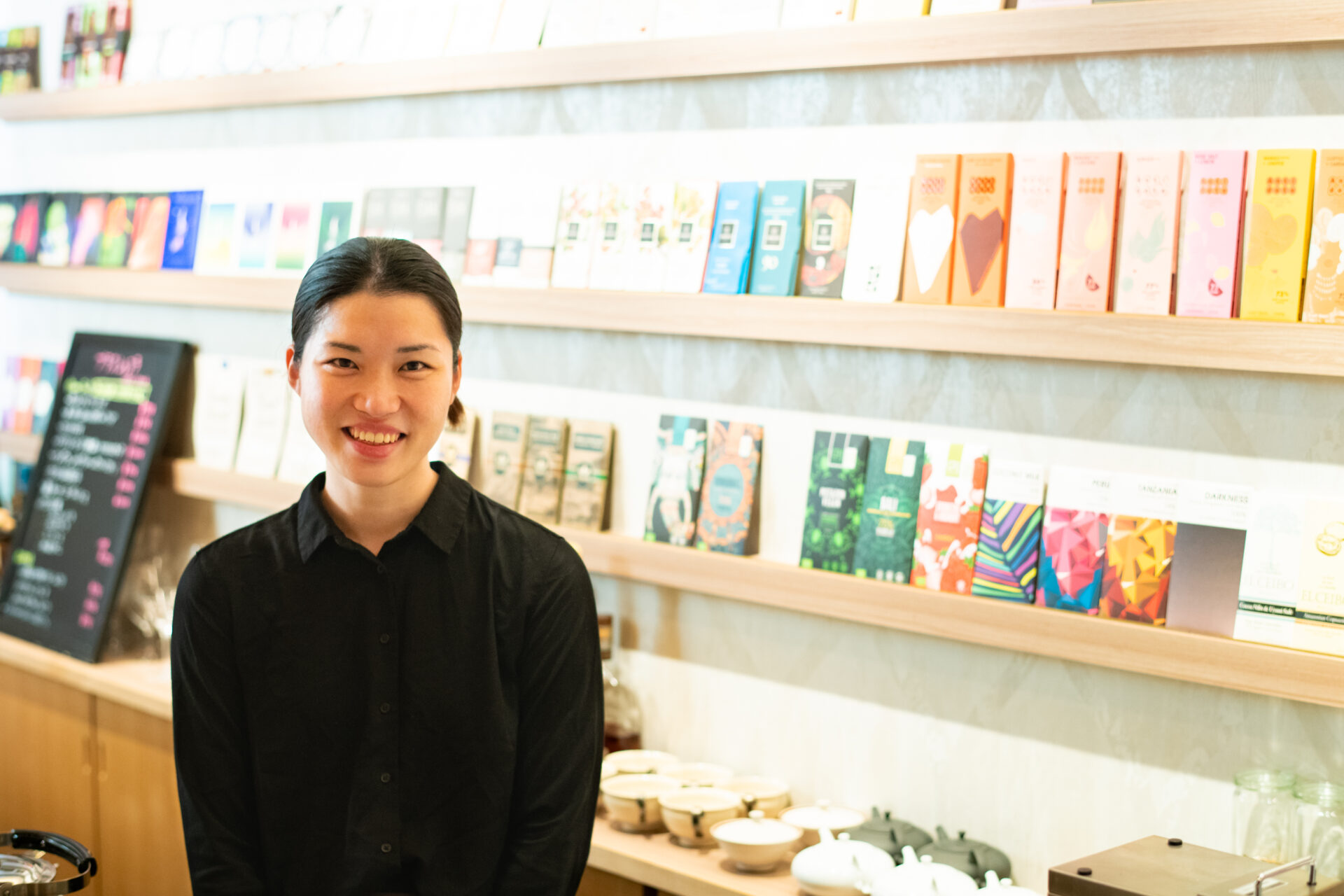Having a piece of chocolate when you are tired has a very relaxing effect. At the same time, eating chocolate can energize your mind and give you a lift before work.
Chocolate is made out of cacao, and recently, cacao is garnering attention for uses other than chocolate such as seasoning for cooking.
Rie Miyahara, the owner of +Chocolat, opened her shop in Kyoto to share the many appeals of cacao. Miyahara fell in love with cacao at a young age and has traveled around the world to eat chocolate. Her shop offers 100 varieties of Bean To Bar chocolates, which are chocolates made by companies that are involved in the whole process of making chocolate, from cacao bean selection to manufacturing. Customers can try different flavors or pair the chocolates with alcoholic drinks. They also serve meals that use cacao as seasoning.
“My hope is to imprint chocolate and cacao in Japanese culture.”
We talked to Miyahara about the attraction of Bean to Bar, her chocolate and drink pairings, cacao as a cooking ingredient and the potential of cacao as a “shikohin.”
Traveling the world in search of delicious chocolate
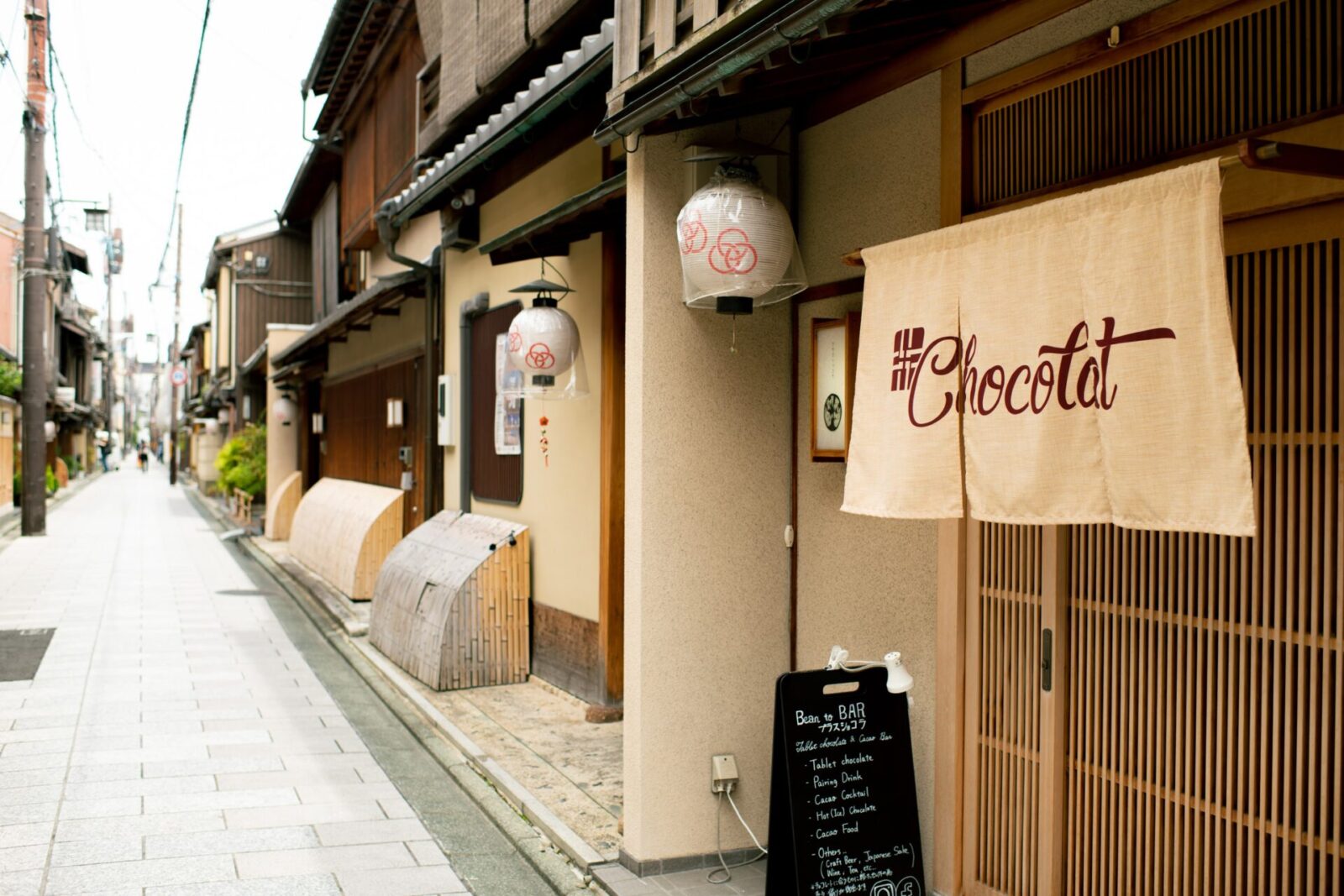
The +Chocolat shop is found in a corner of the Hanamachi district, which is about a five minute walk from Gion-Shijo Station in Kyoto. In the shop, there are Bean To Bar chocolates that come from all around the world.
The shop is inside a traditional “machiya (townhouse)” building and there is a “noren (doorway curtain)” that reads “+Chocolat” at the entrance. The shop has the air of a small restaurant.
When you enter the shop, you take off your shoes and sit down at the Japanese floor table counter. The space has a very relaxing and natural feel.
The opposite wall is lined with various beautiful packages of Bean to Bar chocolates from around the world. Inside the shop, one can taste these different chocolates and pair them with drinks.
The owner of the shop, Rie Miyahara, says that her first experience that got her hooked on chocolate was on Valentine’s Day in her second year of junior high school.
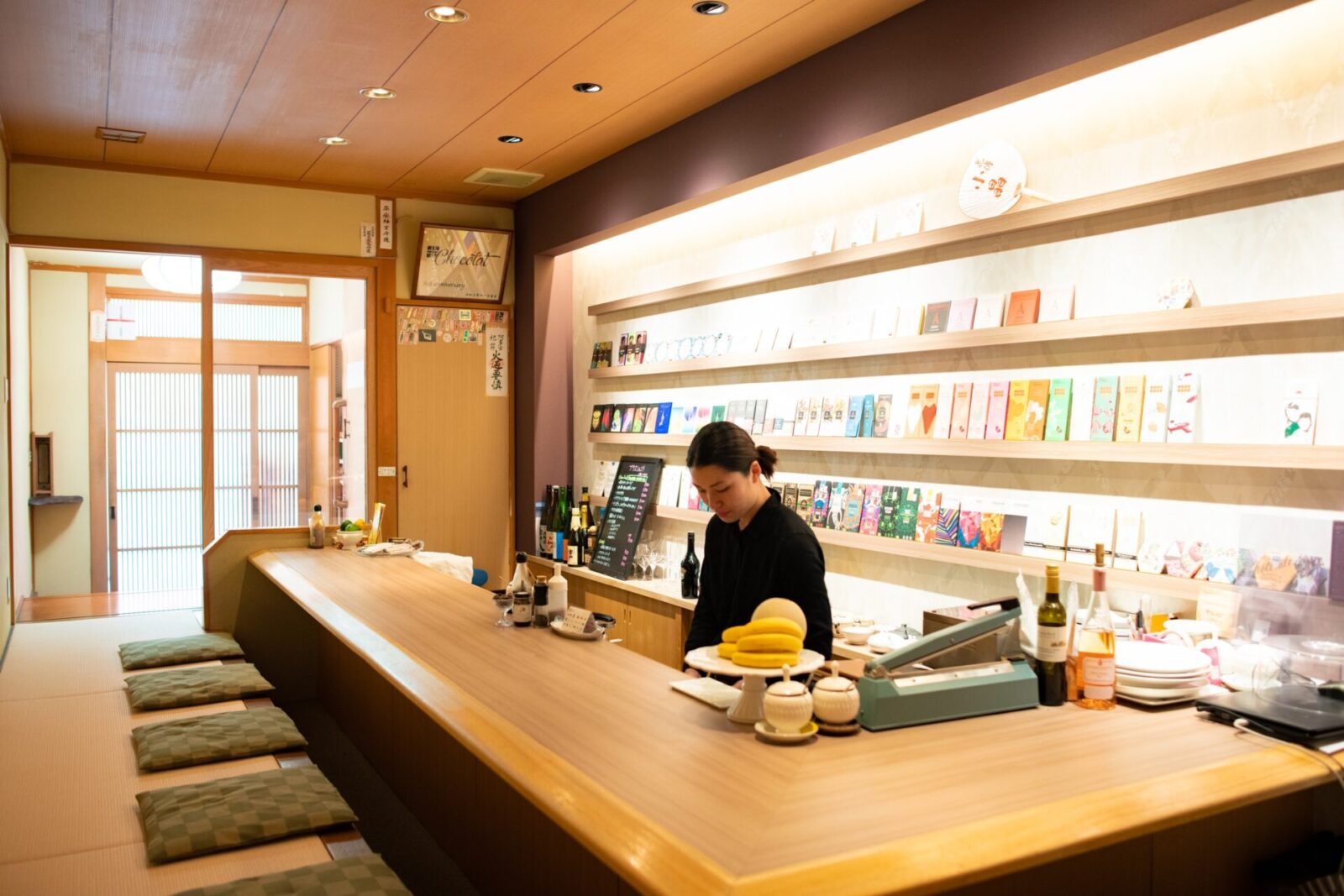
“I wanted to make a delicious chocolate treat for a boy I liked for Valentine’s Day when I was in eighth grade. This experience got me hooked on chocolate.”
“At first I ordered different confectionery chocolates online. I was surprised to find that even though all of the chocolates were sold as dark chocolate, they all tasted differently.”
“When I looked at the labels on the package, I found that all the names of the manufacturers were different, and so were the region of origin and percentage of cacao content. I was so surprised to learn that there was more than just ‘sweet’ and ‘bitter’ flavors of chocolate, but that some chocolate has a sour flavor and that the region of origin and percentage played such a big role in the difference in flavor.”
Miyahara began buying confectionery chocolates and putting them in little aluminum bags to bring to school. She started handing out the chocolates at school to her friends to have them taste the different flavors.
It can be said that this was the beginning of her path towards opening +Chocolat.
Miyahara laughs as she recalls, “I handed out chocolates at school and explained how they were from Madagascar, or from Ecuador with 47% cacao, but my classmates did not show much interest.”
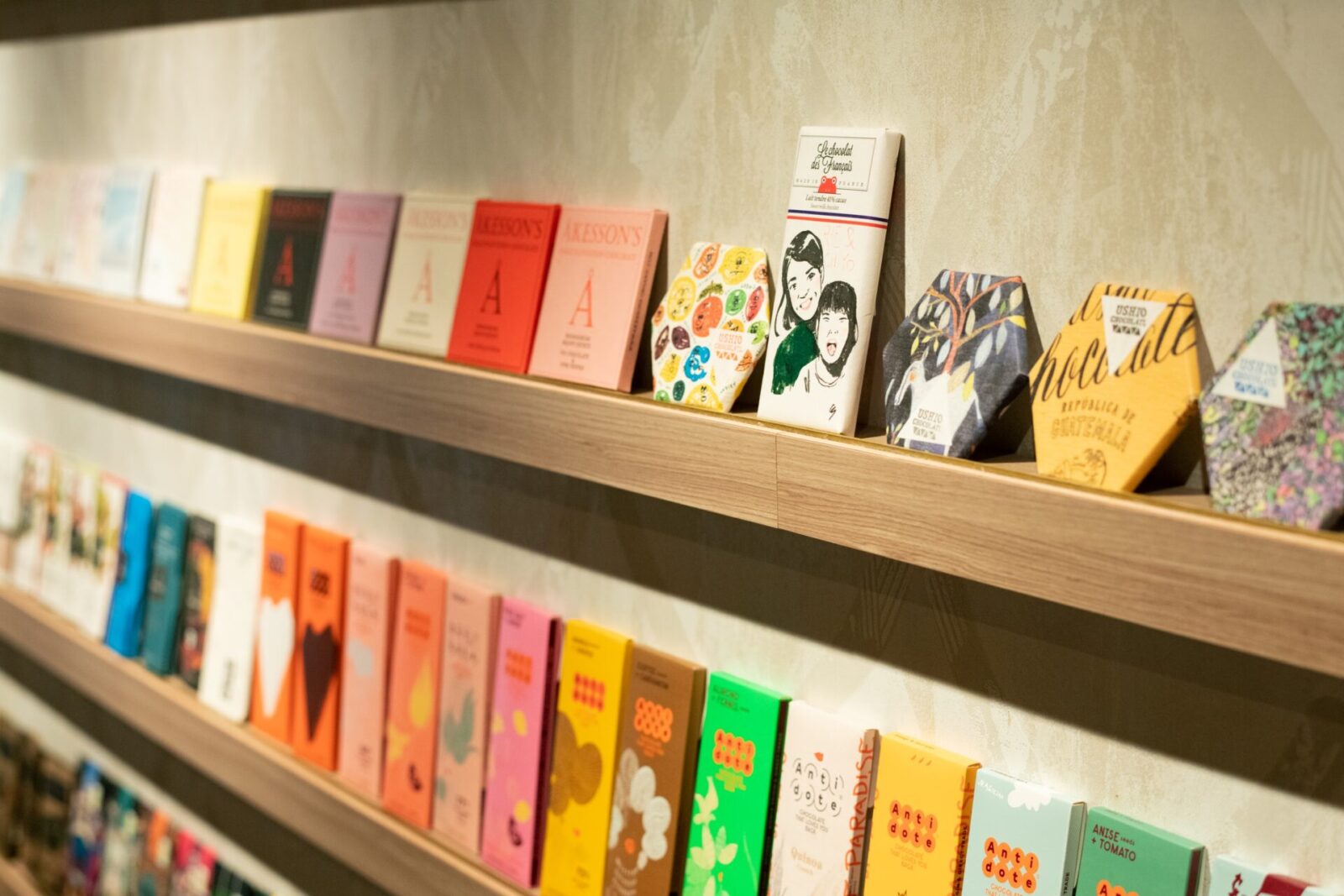
Miyahara began to dream about creating services and products that allows people to really experience the differences in taste and compare the flavors of different chocolates. She believed that this will help people develop a more keen interest in chocolate.
When she was a university student, she discovered Bean to Bar chocolates while studying abroad. Ever since, she has used her vacation days to travel the world to find new and delicious chocolates that are not yet available in Japan.
Miyahara keeps a record and takes notes on the flavors and characteristics of all the chocolates that she brings home. She continued this practice throughout her adulthood, and before she realized, she had a large collection of information. There was a time when the shelves of her home were filled with empty boxes of chocolates that she had consumed and boxes of chocolates that she had not yet eaten, all lined up in alphabetical order. She says that the friends who would visit her home would be surprised at the sheer volume of chocolate she had.
Joining the chocolate importing business as a side job
During Miyahara’s first year of working as a full time employee at an office, she had a chance encounter at a farmer’s market in Aoyama that changed the course of her life.
“I got into a deep discussion with a person who was privately importing Antidote Bean to Bar chocolates, which I was always very fond of. They said to me, ‘If you love chocolate so much, why don’t you import it with us?’ From then on, I started becoming involved in importing chocolates as a side business.”
In 2015, Bean to Bar chocolates were becoming more popular in Japan. Unlike ordinary chocolate, which is made from pre-made chocolate, Bean to Bar chocolates involve the entire process of making chocolate, from cacao bean selection to chocolate production.
This is one reason why many Bean to Bar chocolates are made from cacao beans of a single origin. It allows the consumer to taste the differences of the cacao beans and production methods more clearly.
Furthermore, Bean to Bar products that are imported from overseas have unique package designs that represent the different cultures of the world.

However, once she started privately importing chocolate, she found that although there were many importers, there were very few sales channels.
The shelf life of regular chocolate bars are usually one to two years, but sales of chocolate in Japan are usually concentrated in the two to three weeks before Valentine’s Day. Miyahara learned that many imported chocolates end up going to waste.
“I realized that unless there are more opportunities and places where people can buy and taste Bean to Bar chocolates, the boom will soon be over in Japan. I felt that rather than being an importer, it was critical to create a space to experience chocolate.”
At the end of 2017, Miyahara quit her full time job to dedicate herself to her chocolate business. While she searched for a location to open her shop, she prepared by renting spaces in coffee shops to hold chocolate selling events. In November 2018 she opened +Chocolat.
Finding “the chocolate” from 100 selections
The 100 varieties of Bean to Bar chocolates sold at +Chocolat come from all over the world and are selected based on Miyahara’s vast experiences overseas and the records she has kept on all her tastings.
She selects her lineup based on the ratio of dark, white, and milk chocolates in the total number of her chocolates, has an assortment from different regions, and a balance of different flavors and varieties, such as chocolates that contain nuts.
Although you can order just one chocolate, the chocolate tasting option where you taste three to five varieties of chocolate is most popular at +Chocolat.
The customer first chooses if they prefer sweet or bitter chocolates. For example, if they select a five course bitter chocolate selection, the tasting may include chocolates from different regions and of different acidity and bitterness. It may serve a simple bitter flavor, a bitter chocolate with liquor, and flavored bitter chocolate or one with nuts. Miyahara selects the chocolates according to the requests of the customers.
We tried ordering a tasting course of five chocolates ourselves.
After hearing Miyahara’s experience of how different dark chocolates can taste, we were curious so we asked for two types of bitter chocolate, and “Akkeson’s” chocolate which is a white chocolate as well as one of Miyahara’s top recommendations to be included in the tastings.

Miyahara arranged the below five chocolates, starting with the dark chocolate in the upper right corner and listed clockwise.
Akesson’s (Madagascar Bejofo Estate 75%)
Pump Street Bakery Chocolate TOGO (44% Swiss Milk)
Fjak (68% MORK INDIA)
Akesson’s (43% white Madagascar Bejofo Estate)
‘Original Beans (Esmeraldas Milk 42%)’
“Akesson’s is a brand by a company that has been running a cacao farm in Madagascar for about 100 years. The company has its own large cacao farm and distributes its beans to other manufacturers. Their original chocolates only use the finest beans on their farm so you can really enjoy the best single origin chocolate experience. The 75% dark chocolate has a pronounced berry-like acidity and is favored by those who like lightly roasted coffee.”
“The Fjak is a dark chocolate from Norway. It is made from Indian cacao beans, which have a mild flavor with a distinctive honey-like aroma and low acidity.”
The two dark chocolates are truly polar opposites, with Akesson’s having a refreshing aftertaste and a fruity sourness that quickly escapes the nose, and Fjak having a dense, luscious aroma and a velvety texture on the tongue.
The aroma and taste vary greatly from region to region and farm to farm, and the tasting demonstrates the depth of the Bean to Bar world.
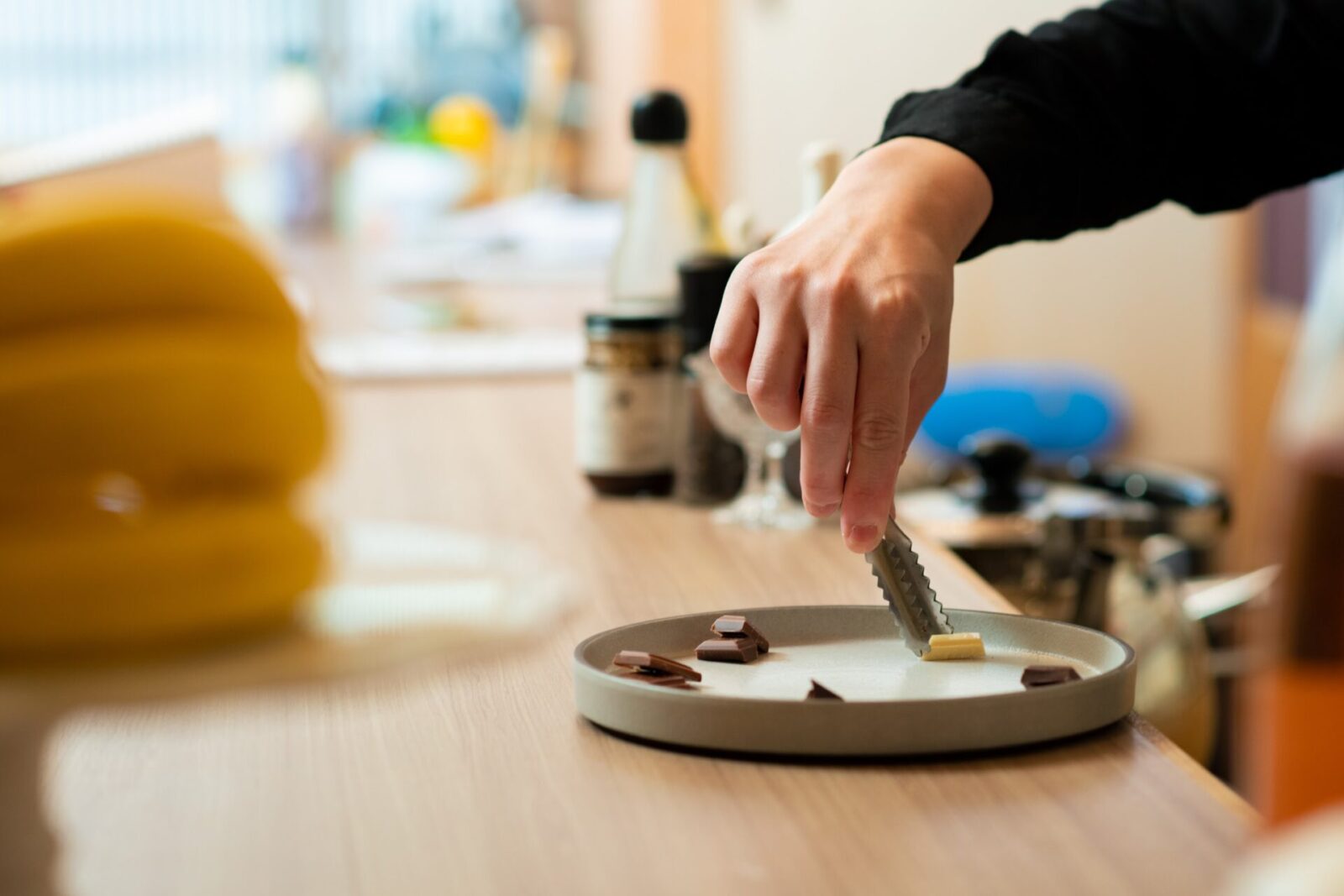
Even their white chocolate demonstrates the highest quality and unique manufacturing methods of each brand.
“White chocolate was originally made by mixing cacao butter squeezed from cacao beans, sugar, and milk powder, but because cacao is more expensive, most white chocolates on the market today is made by mixing different vegetable oils rather than cacao butter.”
“Cacao butter is also often bleached and deodorized to make it a pure white, but Akesson’s white chocolate is made from 100% cacao butter in its pure form, so it has a unique creamy color and you can really taste the cacao flavor.”
Miyahara goes on to say, “In fact, I am not very fond of the regular white chocolate sold in the market today.”
The Akesson’s white chocolate that Miyahara recommends is clearly on a different level than regular white chocolate. The 100% cacao butter has a cheese-like richness, and there is a sweetness and distinct umami. It is a new kind of chocolate experience that stimulates the taste buds of those who eat it.
Expanding the chocolate experience by pairing with alcohol
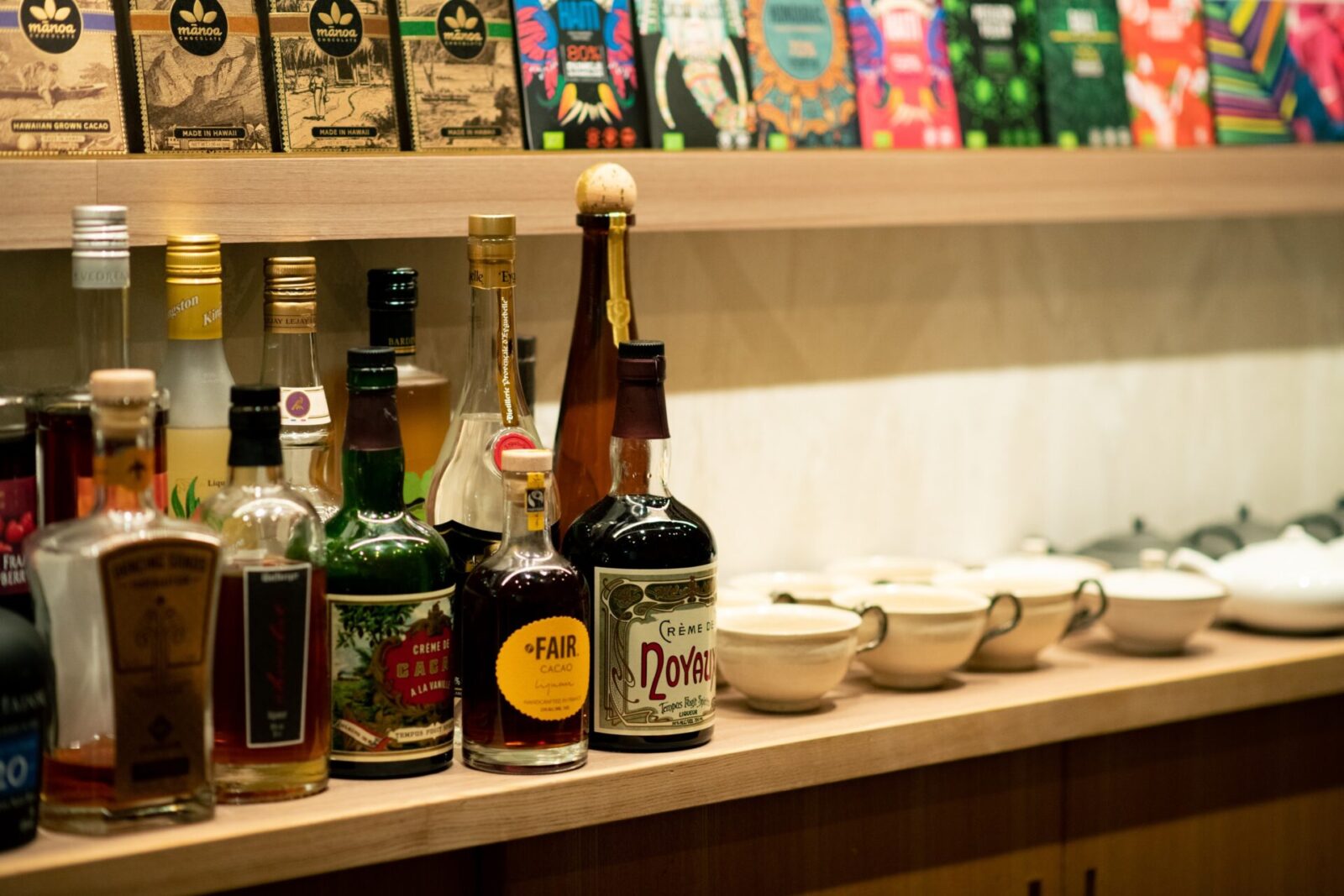
In addition to chocolate tastings, +Chocolat also offers chocolate paired with drinks.
Before Miyahara opened her shop, she went to London and studied food pairing theory.
“Coffee is the most common drink people think of when pairing with chocolate, however, brewing coffee has a very strong aroma that fills the whole room and it makes it difficult to smell the aroma of the chocolate or other drinks. Because of this, we do not serve coffee at +Chocolat.”
Miyahara worked part time at a specialty tea shop when she was in university. With a desire to expand the possibilities of chocolate and drink pairings, she started pairing chocolate with black tea, Japanese tea, sake, wine, shochu, and other alcoholic beverages when she opened her shop.
In restaurants, customers usually choose their drinks to compliment their food, but at +Chocolat, the customers order their drink first and Miyahara suggests which chocolates provide the best pairing.
The pairing of Japanese sake and chocolate is particularly popular.
“I recommend sake that is not light or dry. It does not have to be sweet, but since cacao itself has some acidity, sake with more aroma and acidity is easier to pair with chocolate. Chocolates with malic acid go especially well with sake.”
“The chocolates in our shop are shaped like a tablet and they contain more oil than a
water-soluble chocolate such as ganache, so we need acidity to refresh the palate. If the flavor of the sake is too light or dry, the rich cacao flavor will overpower the flavor of the sake.”
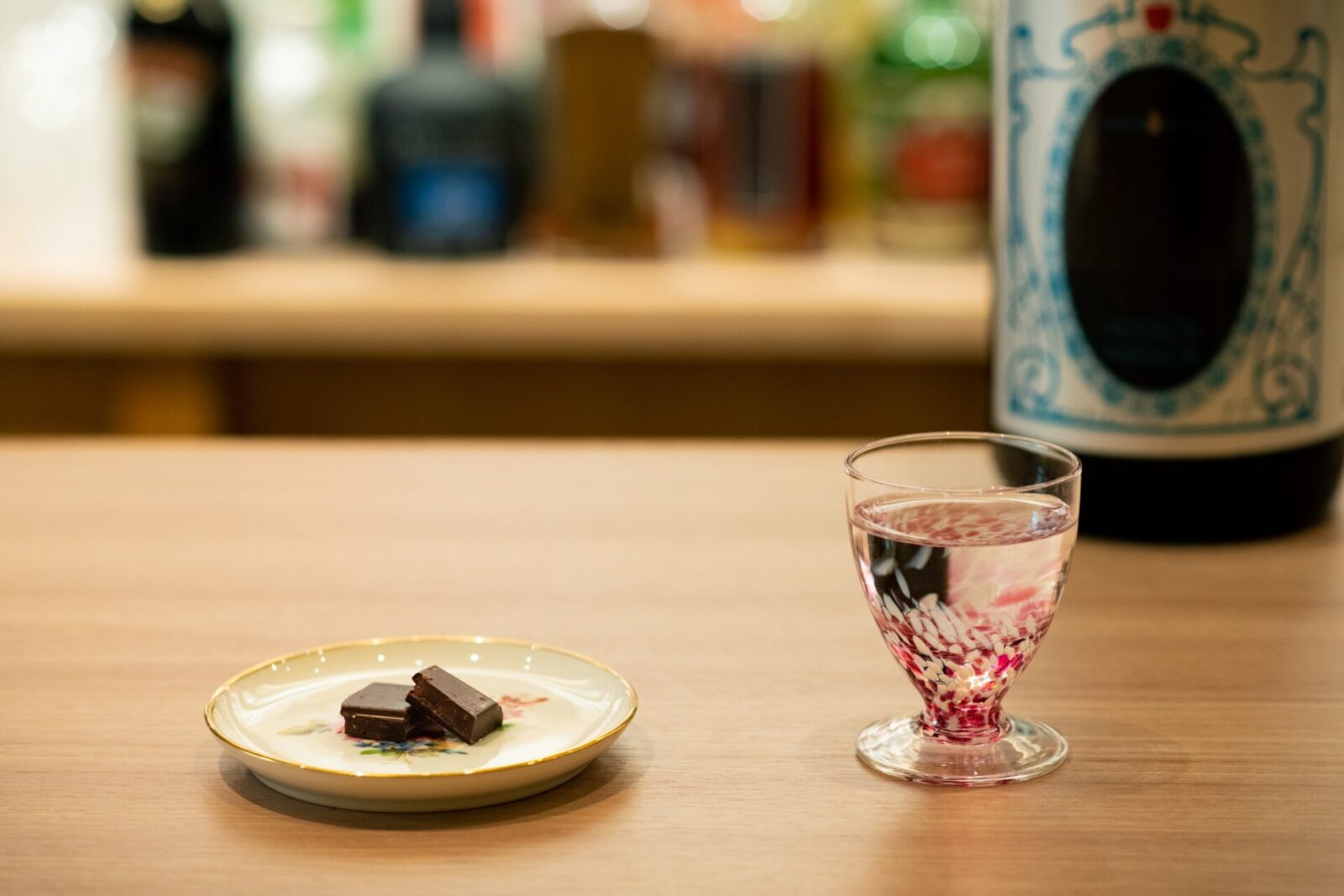
Red wines also pair easily with dark chocolate due to their astringent tannins, so they keep a repertoire of red wines, and they also stock some aromatic white wines. Shochu pairs well with non-acidic chocolates and nutty flavored chocolates.
Beyond chocolate: the true potential of cacao
Meals and drinks that are made out of cacao are also served at +Chocolat.
They have a gorgonzola cheese pasta that is made from pasta with fermented and roasted cacao bean mass kneaded into it. The brown color surprises many people, but it goes very well with alcoholic drinks, especially a light red wine or a heavy white wine with a barrel scent. The strong aroma of the cheese is made lighter by the aroma of the cacao, while leaving the rich flavor of the cheese intact. The dish is a popular item on their menu.

All of their food items use cacao as an ingredient. Cacao mass is added to dishes like their spicy eggplant dish and their meat sauce spaghetti.
“Most people think of cacao only as an ingredient for chocolate, but I look at cacao as a singular ingredient and I hope to expand its possibilities.” Miyahara says.
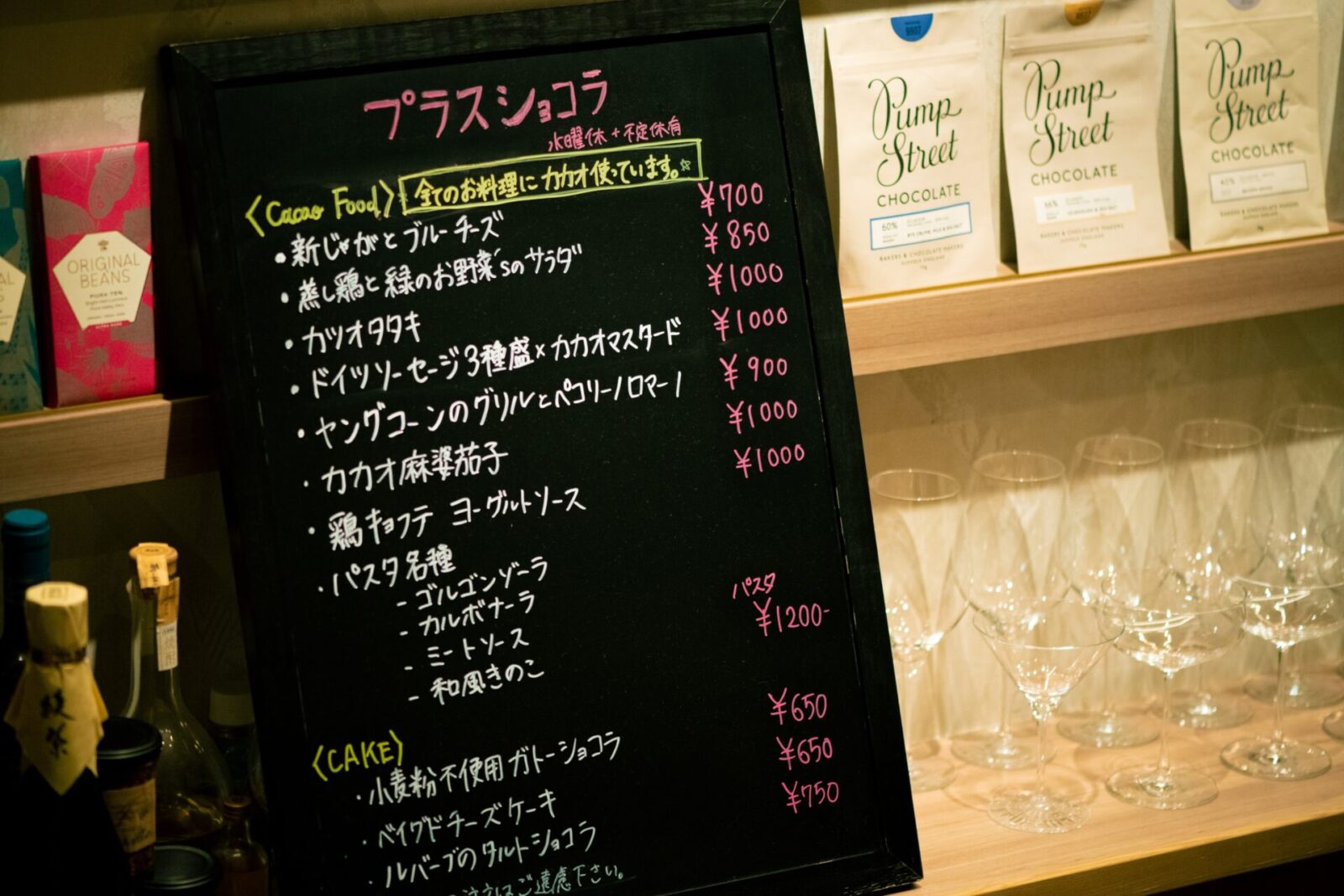
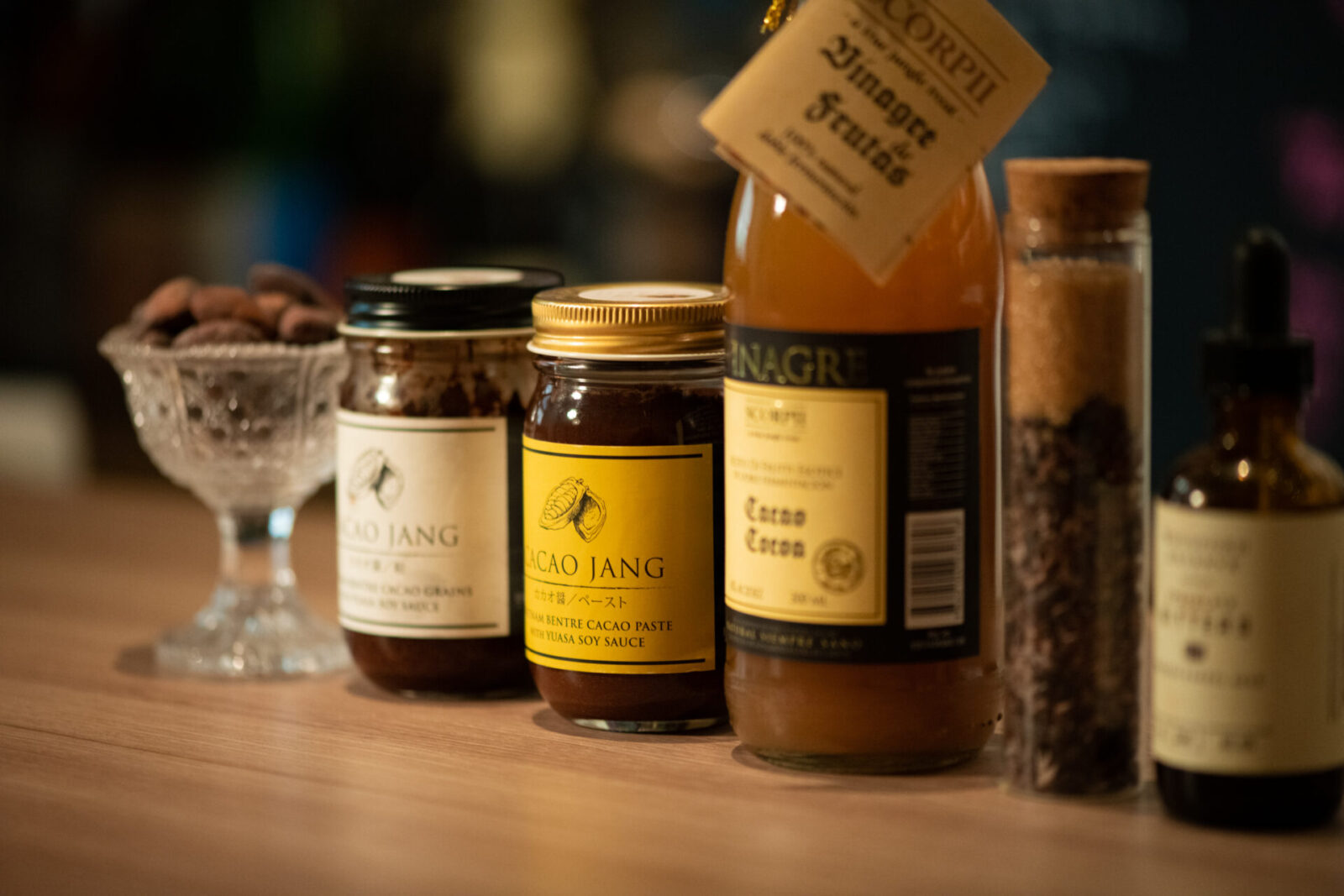
In response to the popularity of the cacao cuisine, they opened a new shop called Cafe +Chocolat Gosho-Kita near Imadegawa Station in Kamigyo-ku, Kyoto City in 2021. It offers set menus, pastas, hot sandwiches, and other dishes that use cacao. Although they do not have chocolate tastings, they sell chocolate at the new shop as well.
Cacao’s unique versatility as both a stimulant and a relaxant
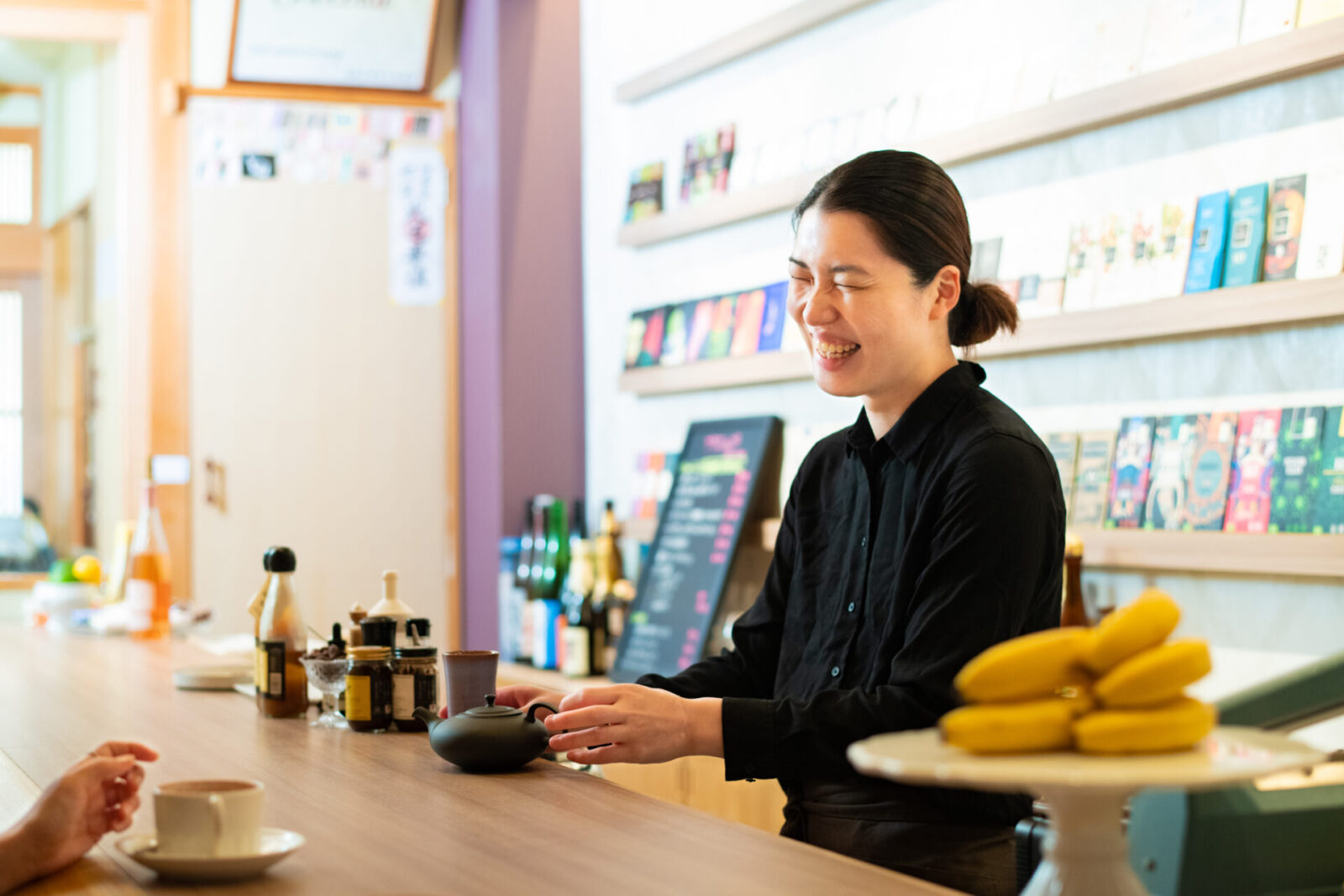
For Miyahara, who has such a deep devotion to cacao, what appeal does cacao have as a shikohin?
“When I feel tired or I want to take a break, having a small piece of chocolate helps take some of the tension out of my body and I can relax. On the other hand, if I want to re-energize myself, I eat a bit of 100% cacao chocolate and it clears my mind and I feel the cacao awaken all of my senses.”
The caffeine found in cacao can have both a relaxing and a stimulating effect on the body. Miyahara, who has mastered cacao, knows how to incorporate cacao in her diet based on her mood and how she is feeling physically.
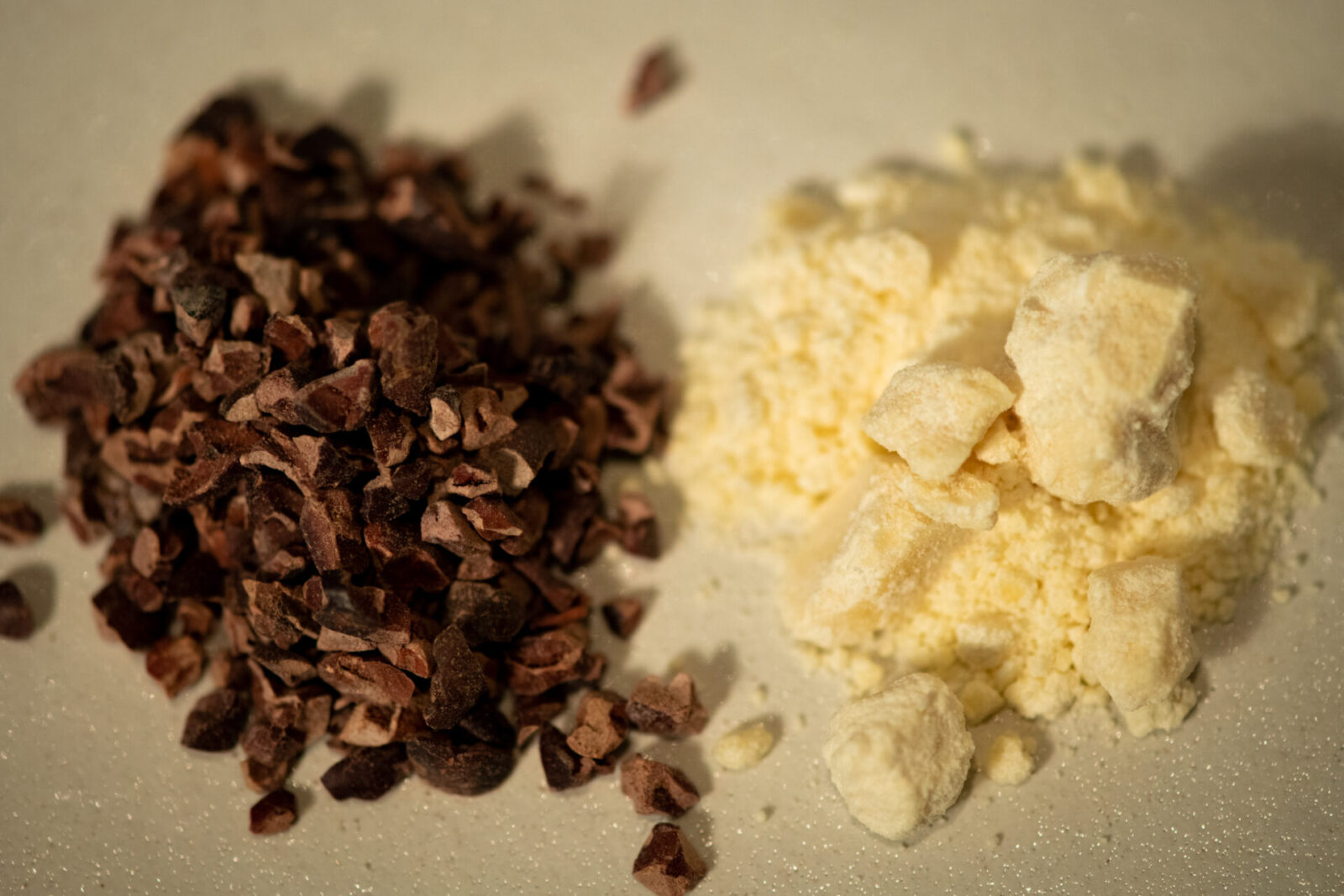
Miyahara explores the world of cacao more than anyone else. She also says that “time in nature that is completely unrelated to chocolate” is a necessity for her.
“My desire to share the appeal of chocolates to more people, which I have had since junior high school, is still at the root of my work.”
“However, I keep my balance by going out and spending time in nature, away from chocolate and cacao, in order to give myself time to absorb other things. One can hear the sounds of birds singing, or the gentle flow of a stream by just walking around Kyoto. I grew up in the countryside in Wakayama, so I often get the urge to go deep into the mountains where there are no people, lay on the ground and listen to the sounds of the water and forest and smell the scents of the earth.”
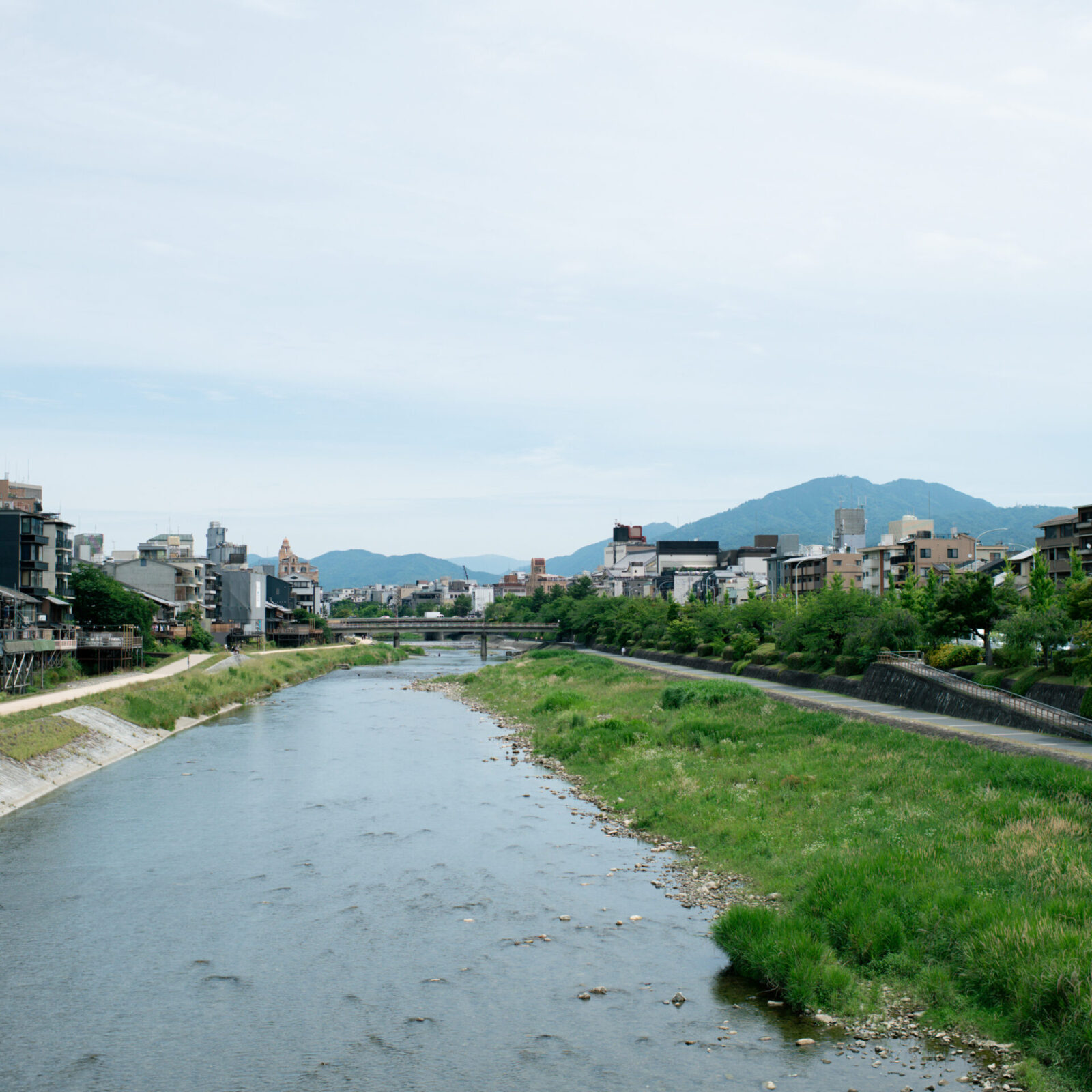
Miyahara reiterates, “In order to imprint chocolate and cacao into Japanese culture, I hope to continue expanding on its possibilities.”
Miyahara has dedicated her life to the exploration of cacao and all her discoveries can be experienced at +Chocolat.
Through our visit, we learned the depth of chocolate, about pairings and cacao’s potential as a seasoning and food ingredient. We learned that the more we explore cacao’s possibilities, the more cacao can enrich our daily lives.
Photo: Yuko Kawashima
Translation: Sophia Swanson
After taking a food sensory test during university and discovering a keen sensitivity to “umami”, she traveled for food in and out of Japan for 25 years. While working at a publishing company, she was in charge of the gourmet food section of a fashion magazine. Later, she worked for an informational magazine before becoming independent in 2013. Now she writes articles and has a series on food for online and printed mazagines.
Yuko Souma is the director of Delightful LLC and was born in 1976 in Chichibu City, Saitama Prefecture. Souma began their career working as an assistant to editor and writers at a production company while studying at Waseda University’s Faculty of Letters, Arts and Sciences. In 2004, Souma was an editor and member of the launch team for the free magazine R25 at Recruit Co., Ltd. They left that role in 2010 and has since produced and edited for magazines, books, online publications, booklets for corporations and municipal governments, and owned media.
